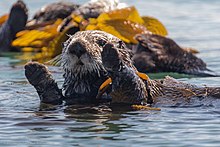This is an old revision of this page, as edited by JennyOz (talk | contribs) at 00:12, 17 February 2022 (→References: refine a cat, add category). The present address (URL) is a permanent link to this revision, which may differ significantly from the current revision.
Revision as of 00:12, 17 February 2022 by JennyOz (talk | contribs) (→References: refine a cat, add category)(diff) ← Previous revision | Latest revision (diff) | Newer revision → (diff) Environmental conservation activity
Sea rewilding (also known as marine rewilding) is an area of environmental conservation activity which focuses on rewilding, restoring ocean life and returning seas to a more natural state. Healthy seas sequester carbon. Globally only 13 per cent of ocean waters are still wild. Rewilding marine and coastal ecosystems offer potential ways to mitigate climate change. There are a range of organisations and projects internationally tackling this area of climate challenge work. Sea rewilding projects are currently less common than those focusing on rewilding land, and seas are under increasing stress from 'The Blue Economy' – commercial activities which further stress the marine environment.
Seagrass

Seagrass meadows store carbon dioxide. More than 90 per cent of the UK's historic seagrass meadows have been lost. Restoring meadows could offset carbon emissions and provide habitat for numerous fish and shellfish species. Research into seagrass, which covers about one per cent of the sea floor suggests that it may be delivering 15–18 per cent of carbon storage in the ocean. Meadows have been declining since the 1930s and are being lost at an alarming rate. Due to their scarcity they have been designated a UK habitat of principal importance. In the United States a project at Chesapeake Bay is considered a success.
Native oysters

Oysters clean waters, recycle nutrients and help to protect against coastal erosion. Oyster stocks have declined by 95 per cent in Europe due to over-harvesting, habitat loss, pollution and disease. Restoring historic oyster beds improves water quality.
Kelp forests

Kelp forests are important habitats which have been lost over time in coastal waters. Kelp forests provide habitat for fish, protect coastlines from erosion and trap carbon dioxide from the ocean. They grow fast and absorb large amounts of carbon. Restoring kelp forests is a strategy to address climate change and enrich ocean livestock.
Marine protected areas
Environmental groups, such as Rewilding Chile, are campaigning to create new marine protected areas.
Carbon capture
Rewilding the sea has been described as "the new way to capture carbon".
Organisations
- Seawilding, a Scottish charity work with communities
- NatureScot
- Rewilding Britain
See also
Further reading
Clover, Charles (9 June 2022). Rewilding the Sea. Penguin Books.
References
- Gregr, Edward (7 July 2021). "Sea otters: how welcome should a recovering top predator be?". TheScienceBreaker. doi:10.25250/thescbr.brk563. ISSN 2571-9262.
- "8 marine rewilding projects around Britain". Rewilding Britain. Retrieved 20 January 2022.
{{cite web}}: CS1 maint: url-status (link) - "Reports". Blue Marine Foundation. Retrieved 20 January 2022.
{{cite web}}: CS1 maint: url-status (link) - "COP 26: Ocean action is climate action and the time to act is now!". Seas at Risk. 2 November 2021. Retrieved 20 January 2022.
{{cite web}}: CS1 maint: url-status (link) - "A drop in the ocean: rewilding the seas". the Guardian. 4 July 2021. Retrieved 17 January 2022.
{{cite web}}: CS1 maint: url-status (link) - "Ocean protection and Marine Directive review: past present future. Interview with Monica Verbeek, Executive Director of Seas At Risk". Seas at Risk. 21 December 2021. Retrieved 20 January 2022.
- Green, Alix Evelyn (28 July 2020). Assessing the impact of environmental pressures on seagrass Blue Carbon stocks in the British Isles (Doctoral thesis). UCL (University College London).
- "Advancing the conservation of seagrass through education influence research and action". Project Seagrass. Retrieved 17 January 2022.
{{cite web}}: CS1 maint: url-status (link) - Dickie, Mure (4 September 2021). "Coastal rewilding: restoring Scotland's seagrass meadows". Financial Times. Retrieved 17 January 2022.
- "Assessment of Blue Carbon Resources in Scotland's Inshore Marine Protected Area Network". NatureScot. Retrieved 17 January 2022.
{{cite web}}: CS1 maint: url-status (link) - ^ "The problem with blue carbon: can seagrass be replanted … by hand?". the Guardian. 5 November 2021. Retrieved 17 January 2022.
{{cite web}}: CS1 maint: url-status (link) - "Out of the Blue: The Value of Seagrasses to the Environment and to People". UN Environment Programme. 4 June 2020. Retrieved 17 January 2022.
{{cite web}}: CS1 maint: url-status (link) - "LIFE 3.0 – LIFE Project Public Page". European Commission LIFE public database. Retrieved 17 January 2022.
{{cite web}}: CS1 maint: url-status (link) - Unsworth, Richard K. F.; Callaway, Ruth. "How underwater gardening can rewild the Atlantic Ocean". The Conversation. Retrieved 23 January 2022.
- "Essex Native Oyster Restoration Initiative". Essex Native Oysters. Retrieved 17 January 2022.
{{cite web}}: CS1 maint: url-status (link) - "Restoring oysters on the Humber". The Wildlife Trusts. Retrieved 17 January 2022.
{{cite web}}: CS1 maint: url-status (link) - "Sussex Kelp Restoration Project". Sussex Wildlife Trust. Retrieved 17 January 2022.
{{cite web}}: CS1 maint: url-status (link) - "Paradigm Shift On How To Restore Kelp Forests". Sea Trees. Retrieved 17 January 2022.
{{cite web}}: CS1 maint: url-status (link) - "Plantwatch: kelp – forgotten forests that help tackle climate crisis". the Guardian. 17 March 2020. Retrieved 20 January 2022.
{{cite web}}: CS1 maint: url-status (link) - "Kelp Forest Restoration Project". The Bay Foundation. Retrieved 17 January 2022.
{{cite web}}: CS1 maint: url-status (link) - "Marine Program". Fundación Rewilding Chile. Retrieved 23 January 2022.
- "Rewilding the sea is the new way to capture carbon, says Eustice". Blue Marine Foundation. 24 June 2020. Retrieved 23 January 2022.
- "Seawilding – an entity, and an idea that was born out of the hopes, aspirations and motivations of a community association called CROMACH". UN Decade on Restoration. Retrieved 17 January 2022.